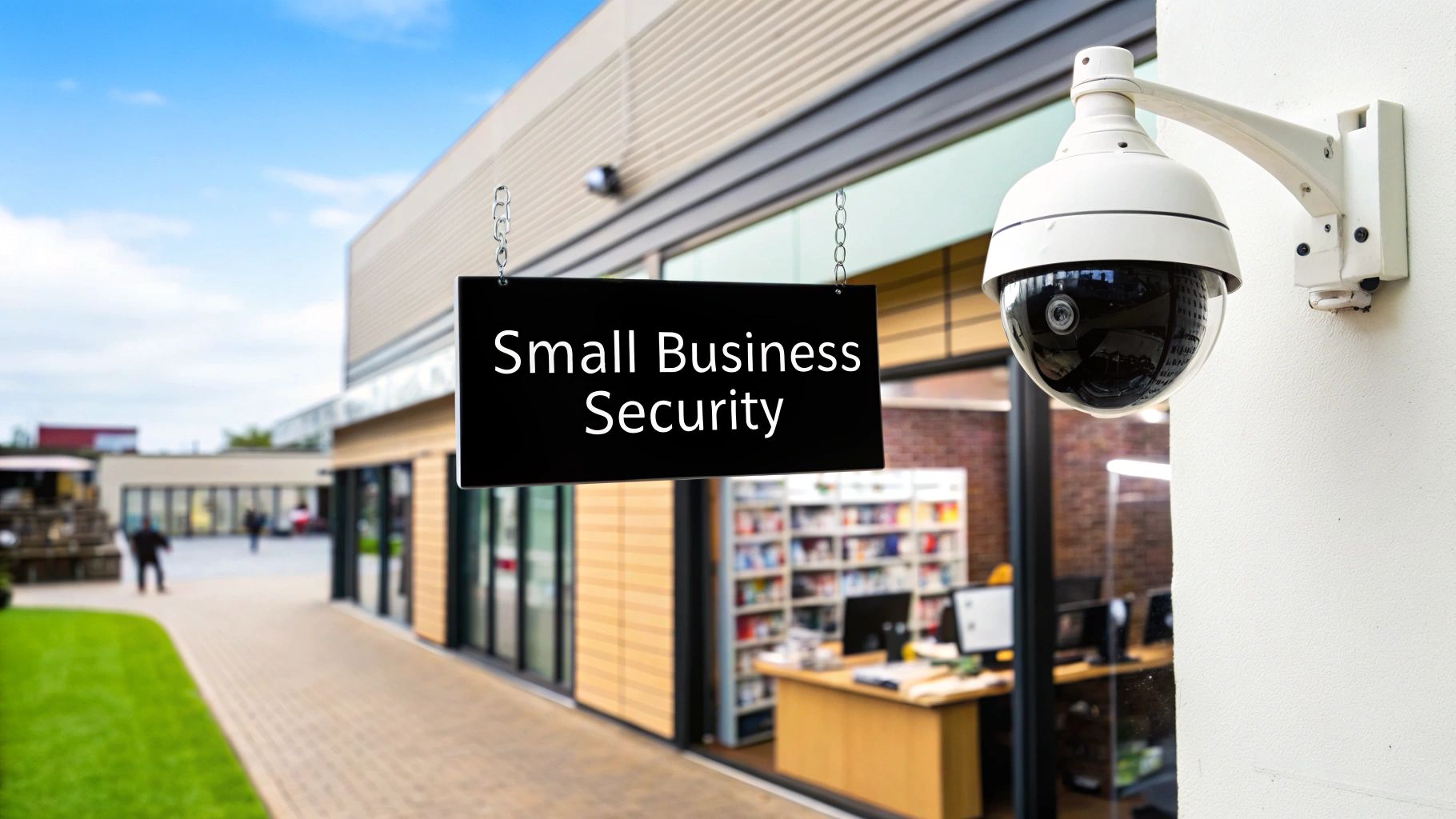Choosing the best security cameras for a small business isn't about finding a one-size-fits-all solution. It's about matching the hardware to your real-world needs. For some, the clear winner is Ubiquiti's UniFi Protect, thanks to its scalable, subscription-free local storage. Others might lean toward Verkada for its powerful cloud management and AI features, while budget-conscious businesses often find Lorex hits the sweet spot with its high-resolution wired systems.
The right system for you will strike the perfect balance between video clarity, reliable storage, and smart alerts that actually help you protect your assets without adding more noise to your day.
Why Investing in Business Security Is a Critical Decision
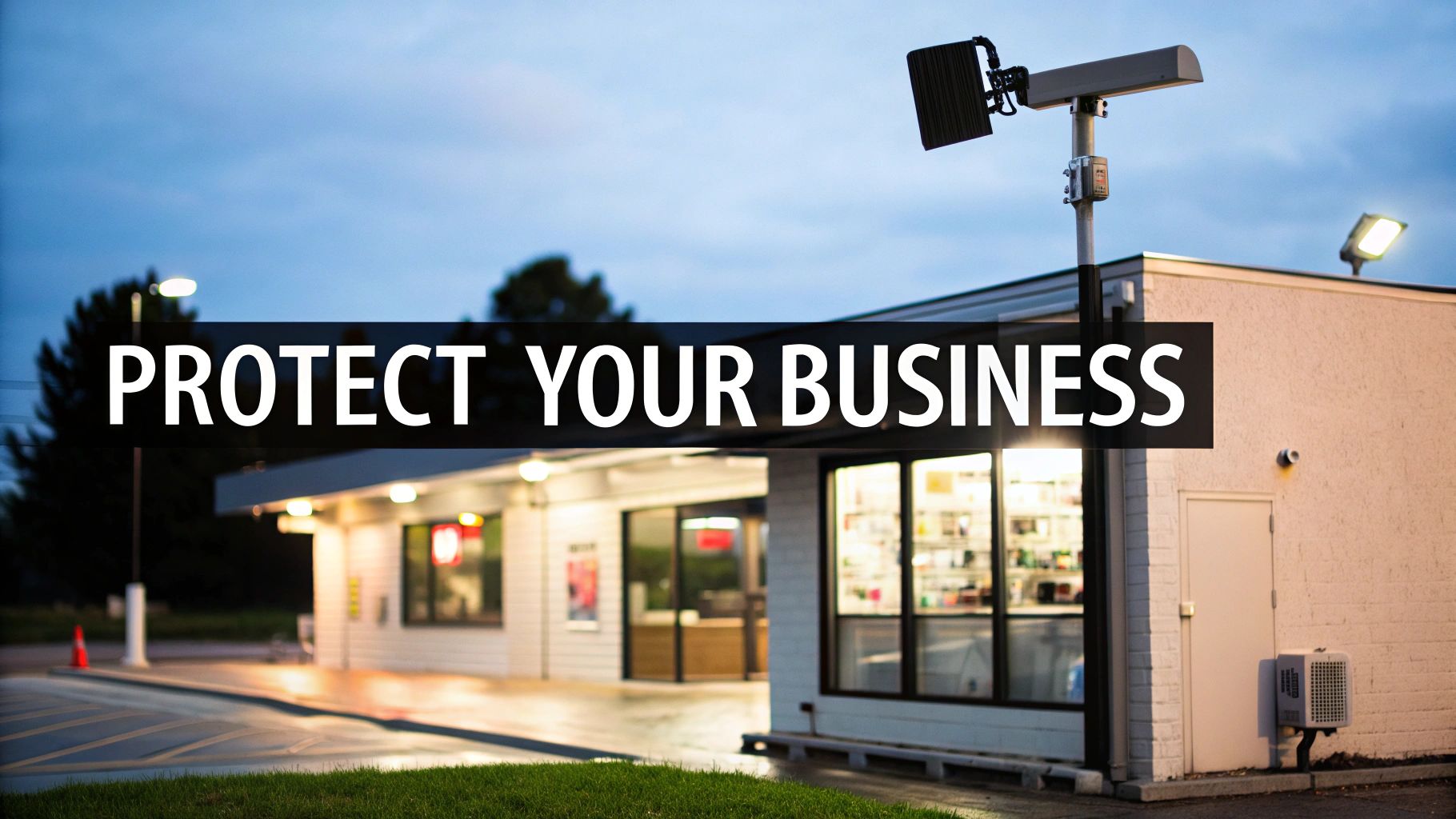
Picking a security system is one of the most important decisions you'll make as a business owner. Think of it less as an expense and more as a strategic investment that goes far beyond just catching shoplifters. A good system is your first line of defense against a whole host of operational risks.
Modern surveillance is crucial for protecting your business from liability claims, discouraging vandalism, and even identifying internal theft, which can slowly eat away at your bottom line.
A well-placed camera is no longer a passive recording device; it’s an active management tool. High-definition footage provides undeniable proof to resolve customer disputes, verify workplace accidents for insurance claims, and create a safer environment for your employees. This evolution from simple recording to intelligent oversight is exactly why the market is expanding so rapidly.
Matching Systems to Business Needs
The growing demand for these systems tells the story. The video surveillance market was valued at around USD 54.42 billion in 2024 and is on track to hit nearly USD 88.71 billion by 2030. This growth is a direct result of better technology and a greater awareness of security needs across all industries.
With so many options out there, it helps to see how different systems fit into common business environments.
Quick Guide to Top Small Business Security Camera Systems
This table gives you a quick snapshot of which systems generally work best for different types of small businesses.
| Business Type | Recommended System | Key Benefit | Best For |
|---|---|---|---|
| Retail Store | Multi-camera PoE NVR system | Facial/license plate clarity | High-traffic areas, POS monitoring, and loss prevention. |
| Office Space | Cloud-managed dome cameras | Discreet design, remote access | Monitoring entrances, common areas, and sensitive data rooms. |
| Warehouse | Weatherproof bullet cameras | Long-range night vision | Securing large perimeters, loading docks, and inventory. |
| Restaurant/Bar | Indoor/outdoor dome system | Wide coverage, low-light performance | Observing dining areas, kitchens, and entry points for safety. |
This overview should help point you in the right direction. The goal is to find a system that aligns with your specific vulnerabilities and operational goals.
The most effective security strategy isn't just about installing cameras; it's about deploying a system that integrates seamlessly into your daily operations and provides actionable intelligence, not just passive footage.
For a more comprehensive look at building a complete security plan, our guide to commercial building security systems offers practical insights for creating a truly protected environment. Next, we'll break down the specific features you need to look for when making your choice.
What to Look For in a Business Security Camera
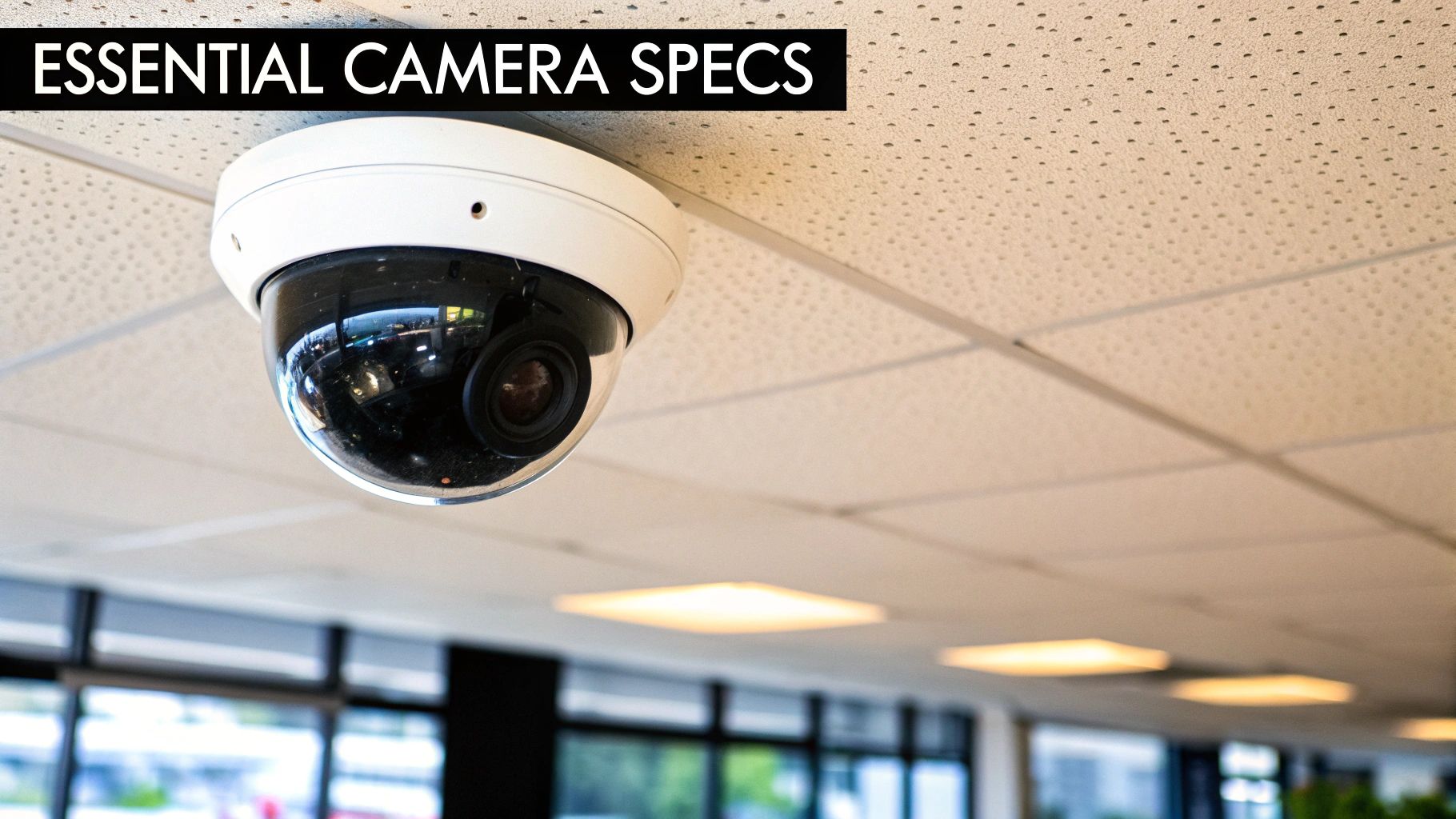
When you start shopping for security cameras for your business, the spec sheets can be overwhelming. But from my experience, only a few key features separate a system that’s genuinely useful from one that just records passively. Focusing on these core functions will make sure you’re investing in a tool that actually helps you run and protect your business.
The first thing to look at is video resolution. While 1080p (Full HD) is still common, I find it often doesn’t cut it in a commercial environment where you need to see small details. If you run a retail shop, you need to be able to zoom in on the cash register or make out a face from across the floor.
That’s where 4K (Ultra HD) resolution really proves its worth. With so many more pixels, you can digitally zoom in on your recordings without the image turning into an unusable, blurry mess. This makes it far more practical for capturing things like license plates in your parking lot or reading labels in an inventory room.
Seeing Clearly, Day or Night
Great surveillance doesn't clock out at 5 PM. Your camera's night vision is just as critical as its daytime performance, but not all night vision is the same. The technology you pick will determine the quality of evidence you can pull from an after-hours incident.
Most cameras rely on standard infrared (IR) night vision. It works by flooding the area with infrared light that we can't see, producing a black-and-white video. It’s fine for seeing that something is moving, but it makes it impossible to tell the color of a getaway car or an intruder's jacket—details that can be crucial for an investigation.
This is exactly why more businesses are shifting to cameras with color night vision. These systems use advanced, ultra-sensitive sensors and sometimes a small, low-light spotlight to capture footage in full color, even in very dark conditions. That single feature can be the difference between a vague alert and a detailed description you can hand over to the police.
The real value of a business security camera isn't just seeing that an event occurred, but capturing enough detail to understand exactly what happened and who was involved. Investing in 4K resolution and color night vision provides that crucial layer of context.
Moving Beyond Simple Motion Alerts
One of the biggest headaches for any business owner is the constant stream of meaningless motion alerts. When your phone buzzes every time a branch sways in the wind or a car drives past, you quickly learn to ignore it. That's where AI-powered detection comes in, turning a noisy camera into a smart security partner.
Modern cameras can tell the difference between people, vehicles, and other types of movement. This lets you set up incredibly specific alerts, slashing the number of false alarms and making sure you only get notified about events that actually matter.
Here’s how this works in the real world:
- Person Detection: The system can ignore pets or blowing leaves and only alert you when a person enters a restricted area after you've closed for the day.
- Vehicle Detection: Perfect for monitoring a loading bay or parking lot. You can get a notification when a truck arrives outside of normal delivery hours.
- Package Detection: If you get a lot of deliveries, this feature is a lifesaver. It can confirm when a package is dropped off and even alert you if someone tries to walk away with it.
These smart features let you put your security monitoring on autopilot. Instead of having to scrub through hours of footage to find what you're looking for, you get precise, relevant alerts that let you act immediately. Prioritizing cameras with these capabilities means your system is actively working for you, not just passively recording.
Wired vs. Wireless: Which System Is Right for Your Business?
One of the first big decisions you'll make when setting up a security system is whether to go with wired or wireless cameras. This isn't just a matter of convenience; it shapes your system's reliability, how complex the installation will be, and its performance down the road. The best choice really boils down to your building's layout, what you need to protect, and what kind of infrastructure you already have in place.
Let's clear up a common misunderstanding right away. "Wireless" doesn't mean zero wires. While these cameras send video footage over your Wi-Fi network, they still need power. That almost always means running a power cord to a nearby wall outlet, making them more "data-wire-free" than truly wire-free.
True wired systems, on the other hand, are the workhorses of professional security, and for good reason. They offer a far more robust and integrated solution.
The Case for Wired PoE Systems
When security is absolutely critical, a wired system using Power over Ethernet (PoE) is the gold standard, no question. PoE is a brilliant piece of tech that lets a single Ethernet cable deliver both high-speed data and electrical power straight to the camera. This elegant design delivers some serious advantages.
First off, you get rock-solid reliability. A hardwired connection isn't going to drop because of a weak Wi-Fi signal, interference from other devices, or thick concrete walls. Your video feed stays smooth and constant, which is non-negotiable when you're watching a cash register, server room, or high-value inventory.
While the initial installation is more involved, the final result is often much cleaner. Since one cable does it all, you won’t have a mess of power adapters and cords at every camera location. For small businesses, pairing PoE cameras with a Network Video Recorder (NVR) is one of the most dependable and scalable setups you can get. An NVR gives you a central hub to record and store weeks, or even months, of footage locally—invaluable if you ever need to investigate an incident. You can find more expert advice on business camera systems over at backstreet-surveillance.com.
Think of a wired PoE system as a private, dedicated highway for your security footage. It’s built for performance and doesn’t get stuck in the traffic jams that can clog a busy Wi-Fi network, ensuring your most important video always gets through.
Imagine you run a few retail stores. You need flawless, 24/7 recording at every checkout counter and in each stockroom. A wired PoE system connected to an NVR in each location guarantees that all the critical footage is captured in crisp high definition, without ever missing a beat.
The Flexibility of Wireless Wi-Fi Cameras
As great as wired systems are, they aren't always practical. That's where wireless cameras come in, offering a level of flexibility that can be a real game-changer in certain situations. Their biggest selling point is the freedom to install a camera just about anywhere you have a power outlet and a decent Wi-Fi signal.
This makes wireless systems a fantastic fit for:
- Older or historic buildings: Drilling through thick brick or concrete to run new Ethernet lines can be incredibly expensive or flat-out forbidden.
- Detached or hard-to-reach areas: Need a camera on a separate workshop or a storage shed across the lot? A wireless camera can join the network without the hassle of digging trenches for cables.
- Temporary or changing layouts: If you run a business that reconfigures its space often, like a pop-up shop or an event venue, you can move and reposition wireless cameras with almost no effort.
A small boutique in a historic downtown building is a perfect example. The owner needs to watch the front door and a back storage area but is restricted from making major alterations to the structure. A couple of wireless cameras can be up and running in minutes, providing essential security without the headache and cost of a full wired install. This adaptability makes wireless a powerful choice for any business that values easy setup and versatile placement over an ironclad connection.
Comparing Top Security Camera Systems for Business
Choosing the right security cameras for your business means looking past the marketing jargon and digging into how these systems perform in the real world. A camera system that works great for a quiet office could be a total miss for a busy retail shop. This breakdown gets into the nitty-gritty, comparing leading systems on the features that actually matter to a small business owner.
We’ll be looking at everything from how painful the installation is to video clarity after dark, the smarts behind their AI alerts, and how you'll store all that footage. This way, you can match a system’s true strengths to your specific business needs.
Installation And Setup Complexity
The setup process is a huge consideration, especially if you don't have an IT team on standby. This is where wireless systems really shine.
It's no surprise that wireless smart cameras are becoming a go-to for small business owners. In fact, about 67% of users now lean toward wireless systems because you can pretty much install them yourself and place them anywhere without drilling and running cables everywhere. They're also packed with handy features like custom motion zones and AI that can tell the difference between a person, a car, and the neighborhood cat.
On the flip side, you have wired Power over Ethernet (PoE) systems from brands like Lorex or Ubiquiti UniFi Protect. These require more upfront work, no doubt about it. You’ll be running ethernet cables through walls and ceilings, which takes some planning and elbow grease. But the payoff is a rock-solid, reliable connection and a super clean look with no dangling power cords. If you're considering going this route, our guide on commercial security systems installation walks you through what to expect.
This decision tree helps visualize that first big choice between reliability and flexibility.
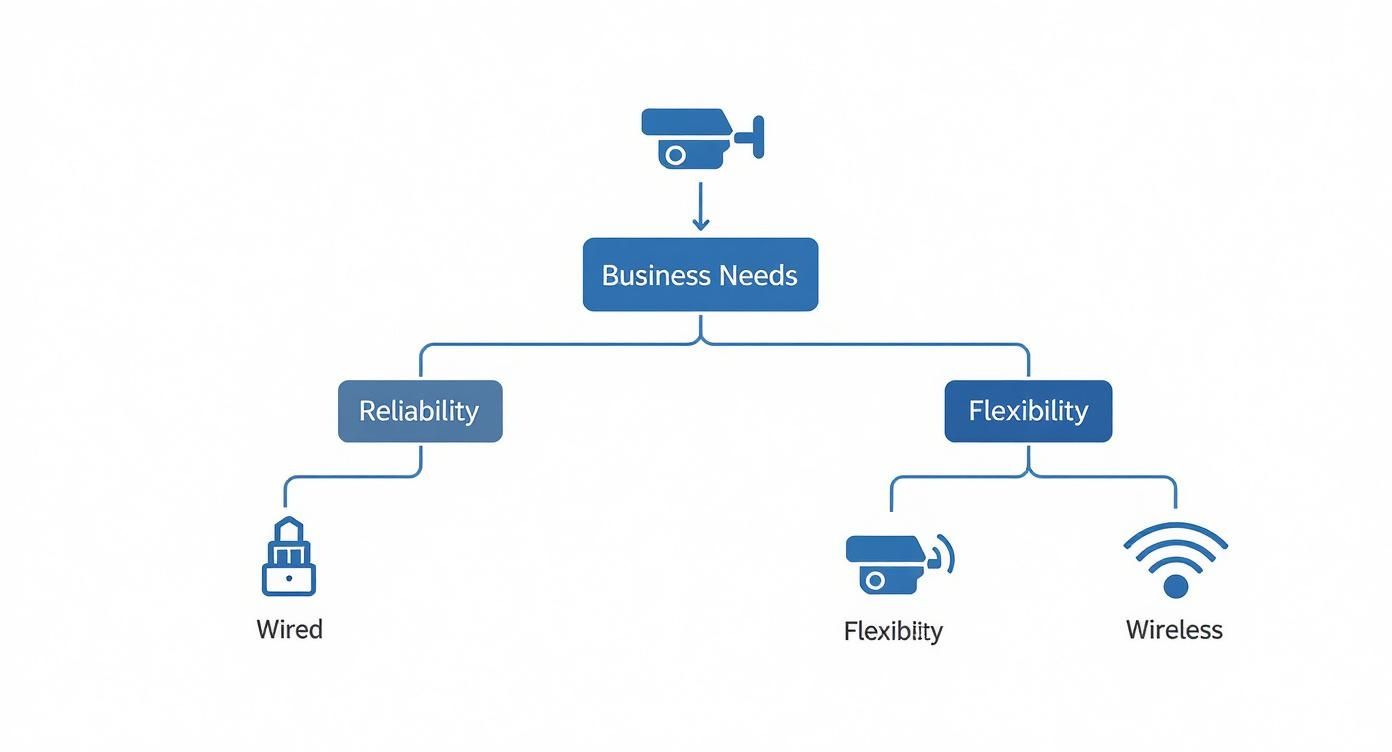
It really boils down to this: if you absolutely cannot afford a dropped connection over critical areas, wired is the way to go. If you need to get cameras up quickly and want the freedom to move them later, wireless is your best bet.
Video Clarity And Night Vision Performance
Video quality is one of those things you just can't compromise on. If the footage is too grainy to be useful, what's the point? Brands like Arlo and Verkada are known for their crisp 2K and 4K resolution, which gives you the detail you need to actually identify a face or make out a license plate. That clarity is invaluable when you need evidence.
But resolution is only half the battle. How a camera performs after the sun goes down is what really separates the good from the great. Standard infrared (IR) night vision can often give you those ghostly, washed-out black-and-white images where everyone looks like a blurry figure.
Some of the better systems now feature advanced color night vision. By using extra-sensitive sensors, they can pull in enough ambient light to produce a full-color picture in very low light. This is a game-changer for outdoor cameras, where knowing the color of a car or a jacket could be the key detail in an investigation. Even though this expert review of security cameras is aimed at homeowners, it does a great job of breaking down core performance metrics that apply just as well to a business.
Verkada's Differentiator: Best for Scalable Multi-Site Management. Its cloud-native platform is brilliant for anyone managing multiple locations. You can seamlessly view and manage cameras across dozens of storefronts or offices from a single dashboard, making it perfect for franchises or growing companies.
AI Alerts And Smart Detection Accuracy
Nothing will make you ignore your security system faster than constant false alarms. If your phone buzzes every time a branch sways or a car's headlights sweep across the parking lot, you'll eventually tune it all out—and risk missing a real alert. This is where the quality of AI-powered detection makes all the difference.
Systems from Google Nest and Ring have really honed their algorithms to be impressively accurate. They do an excellent job filtering out the noise and only alerting you to actual people, vehicles, or packages. This intelligence turns your camera from a simple motion detector into a vigilant security guard.
For instance, a restaurant owner could set up an alert to trigger only when a person is detected by the back door after hours, completely ignoring the raccoons that rummage through the dumpster every night. That level of precision makes your security proactive, not just a reactive chore.
UniFi Protect's Differentiator: Most Robust for Subscription-Free Local Control. For business owners who hate monthly fees, this is the system. By pairing UniFi cameras with their own local recording device (an NVR), you get all the advanced AI features and remote access without a mandatory subscription. It's the best of both worlds.
Storage Flexibility Local NVR vs Cloud
Where and how your footage is stored is a fundamental choice that impacts your costs, access, and data security. You’re essentially choosing between a local Network Video Recorder (NVR) and a cloud-based subscription.
- Local NVR Storage: This is the old-school, reliable method championed by systems like Lorex and UniFi Protect. You buy an NVR box and hard drives once, and that’s it. You own your footage, control it completely, and have zero monthly storage fees. It's a great fit for businesses needing to record continuous, 24/7 footage to comply with regulations.
- Cloud Subscription Storage: Brands like Verkada, Arlo, and Ring are built around this model. You pay a recurring fee per camera to have your video securely stored off-site. The big wins here are that you can access your footage from anywhere and it’s safe from on-site theft or damage.
The right choice often comes down to your internet connection and operational style. A hybrid setup is becoming really popular, where you record everything locally but have important motion-triggered events automatically backed up to the cloud.
Feature-by-Feature System Comparison
To pull it all together, here’s a straightforward table comparing the top contenders on the criteria that matter most for a small business.
| System/Brand | Best Use Case | Resolution & Night Vision | Storage Options | AI Features | Average Cost Per Camera |
|---|---|---|---|---|---|
| UniFi Protect | DIY-focused businesses wanting local control without fees | 2K/4K, Enhanced IR | Local NVR Only | Person, Vehicle, Package Detection | $150 – $400 |
| Verkada | Multi-site businesses needing centralized cloud management | 4K, Advanced IR | Cloud (Required Subscription) | Advanced People/Vehicle Analytics | $300 – $800+ |
| Lorex | Businesses needing high-res wired systems on a budget | 4K, Color Night Vision | Local NVR (Included) | Basic Person/Vehicle Detection | $100 – $300 |
| Arlo | Flexible wireless setups for smaller spaces | 2K/4K HDR, Color Night Vision | Cloud & Optional Local Backup | Person, Vehicle, Animal, Package | $200 – $350 |
This at-a-glance comparison should help you quickly narrow down which system's philosophy and feature set best align with your business goals and budget.
Finding the Right Fit for Your Business Environment
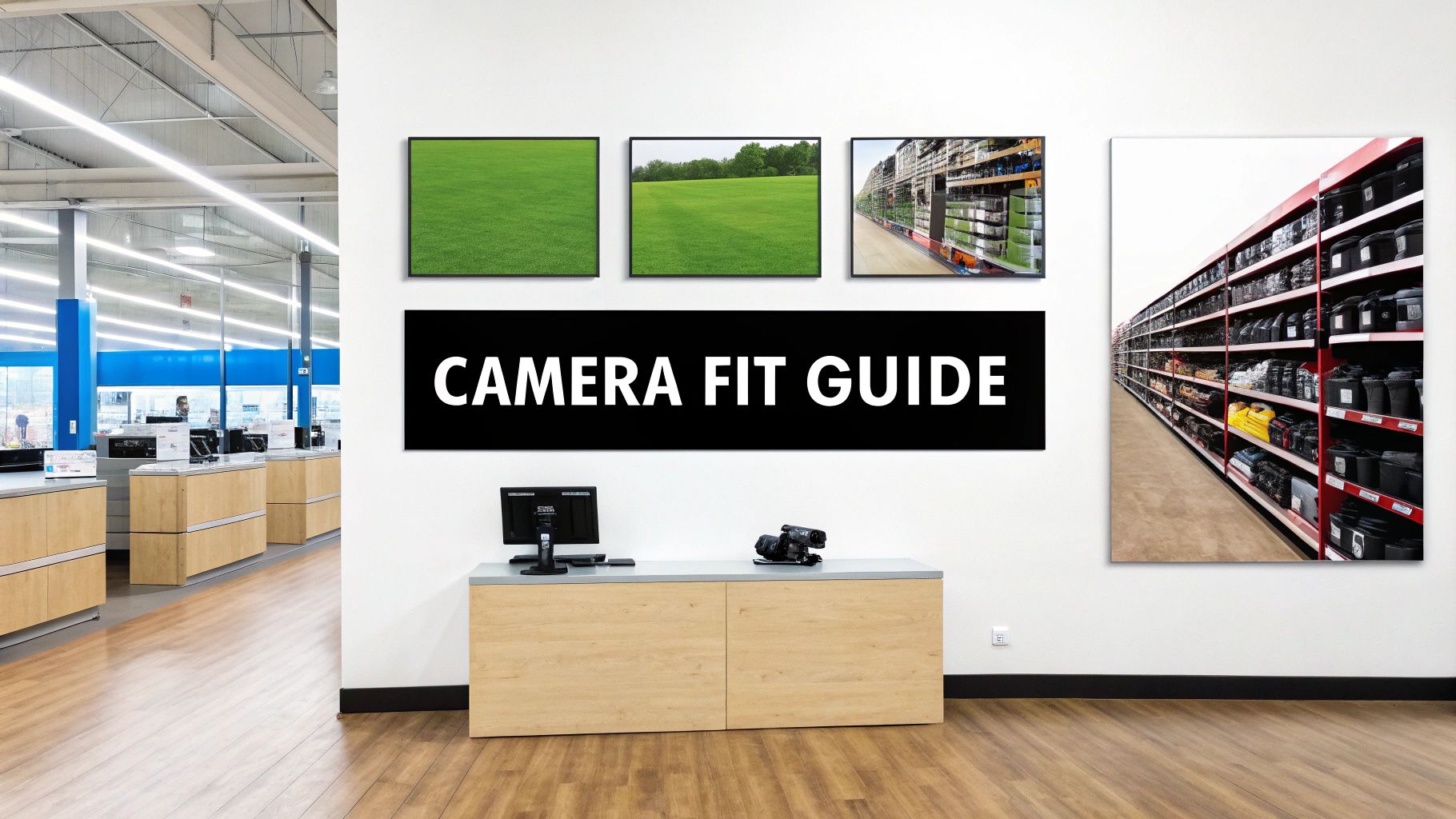
The best security camera system isn't about brand names or a long list of tech specs. It's about how well it solves the real-world problems your business faces every day. A camera that’s perfect for a quiet office will be completely out of its depth in a busy retail store or a huge warehouse. This is where we get practical.
Matching the right features to your physical space and daily operations is the most important step. Let’s walk through a few common business scenarios to see how the right technology translates into real protection and adds value to your bottom line.
Securing a Retail Store
Retail shops are a unique challenge. You’re dealing with everything from shoplifting and employee theft to customer disputes right at the register. Your camera system needs to do more than just passively record—it has to deliver undeniable proof in high-traffic, often chaotic situations.
For retail, a multi-camera wired PoE system is really the only way to go. It gives you the rock-solid reliability you need for 24/7 recording. From there, it's all about smart placement and choosing cameras with features that solve retail's biggest headaches.
- Wide-Angle Dome Cameras: Place these over your main aisles and open floor space. Their wide view is perfect for tracking customer flow and spotting suspicious behavior, and the dome design is less intimidating than a big bullet camera.
- 4K Varifocal Cameras at POS: The checkout counter is where crystal-clear video matters most. A 4K camera with a varifocal lens lets you zoom in on cash handling, verify product scans, and get crisp facial images. This is your best defense when a transaction is disputed.
- AI-Powered Analytics: Modern systems can do more than just record. Heat-mapping can show you which displays get the most attention, giving you great merchandising data. Person detection can also send you an alert if someone is loitering near a high-value display after hours.
In retail, your camera system needs to be a mix of obvious deterrence and discreet observation. You want to capture irrefutable evidence at key spots while also learning more about how customers move through your store.
Protecting an Office
Office security is less about preventing stolen inventory and more about controlling access and protecting sensitive data. The goal is to monitor key entry points and secure private areas without making employees feel like they're under constant surveillance.
A combination of discreet cameras and smart access control is the perfect fit. Cloud-managed systems shine here, as they make it easy for an IT person or business owner to check in from anywhere.
You’ll want a system that can:
- Integrate with Access Control: Tying your cameras to a key card system is a game-changer. You can instantly pull up the video clip for every single door scan, making it dead simple to see who entered the server room and exactly when.
- Provide Discreet Monitoring: Low-profile dome or turret cameras blend right into the ceiling tiles in lobbies, hallways, and common areas. They provide crucial oversight without being a distraction.
- Secure Entrances and Exits: A high-resolution camera pointed at the main entrance is absolutely non-negotiable. It creates an essential digital log of every visitor, delivery, and employee who comes and goes.
Monitoring a Warehouse
Warehouses are a whole different beast. You're dealing with massive spaces, poor lighting, multiple loading docks, and huge perimeters. This environment demands tough, rugged cameras built for long-range surveillance in any weather.
A powerful, wired PoE NVR system is the only reliable choice. Wi-Fi signals just can't cope with the thick concrete walls and metal racking common in industrial settings.
Your warehouse security plan should be built around these key features:
- Long-Range Night Vision: Look for cameras with beefy infrared (IR) illuminators that can see 100 feet or more in absolute darkness. This is critical for keeping an eye on inventory stacks and fence lines overnight.
- Weatherproof Bullet Cameras: Any camera mounted outside needs to be able to take a beating from the elements. An IP67 rating is the standard to look for—it means the camera is completely sealed against dust and rain.
- PTZ (Pan-Tilt-Zoom) Capabilities: A single PTZ camera can do the work of several fixed cameras. It can actively monitor a huge area like a loading dock, allowing an operator to follow a vehicle or person in real time. It adds a dynamic, responsive layer to your security.
When you're trying to pin down the real cost of a security system, looking at the sticker price of a camera is just the first step. To really figure out the best security cameras for your small business, you have to think about the total cost of ownership (TCO). That means adding up every single expense you'll encounter from day one until years down the road. It's a common mistake to overlook these "hidden" costs, which can easily turn a seemingly good deal into a major budget headache.
The initial hardware purchase is what everyone focuses on, but don't forget about installation. Professional setup fees can vary wildly. It's always a good idea to get a few local quotes, because security cameras installation costs are heavily influenced by how complex your system is and the labor rates in your area.
Recurring Costs and Long-Term Expenses
The real budget-busters are often the recurring fees. So many modern systems push you toward cloud storage subscriptions, which usually charge per camera, every single month. It’s undeniably convenient, but those fees stack up fast, especially if you plan on expanding your camera network over time.
You also have to think about long-term maintenance. Will you be on the hook for paid software updates or equipment replacements? A self-hosted system, like one with an NVR, might feel like a bigger hit to the wallet upfront, but it can literally save you thousands in subscription fees over just a few years. If you want to get into the nitty-gritty of this, check out our complete guide on the true cost of a business security system.
The most financially sustainable security solution is one where you've anticipated every expense, from the day of installation to year five of operation. Don’t just budget for the cameras; budget for the entire ecosystem that supports them.
Let's make this real. Here’s a look at how two popular setups would likely play out over a three-year span. This side-by-side shows just how dramatically the cost structures can diverge.
Three-Year Cost Projection: NVR vs. Cloud
| Cost Factor | Self-Hosted NVR System (8 Cameras) | Cloud Subscription System (8 Cameras) |
|---|---|---|
| Initial Hardware | High (Approx. $2,500 for cameras & NVR) | Low (Approx. $1,600 for cameras) |
| Installation | Moderate (Approx. $800) | Low (Approx. $400 for simpler setup) |
| Monthly Fees | $0 | High (Approx. $120/month @ $15/camera) |
| 3-Year Total Cost | $3,300 | $6,320 |
As you can see, the self-hosted NVR system comes out way ahead over three years, even with its much higher initial price tag. The monthly subscription fees for the cloud system quickly eat up any upfront savings and then some, making the NVR the smarter long-term play for most businesses.
Common Questions We Hear About Business Security Cameras
Picking the right security camera system for your small business usually boils down to a handful of critical questions. Getting these answers straight before you buy is the key to investing in a system that actually works for you, giving you peace of mind from the get-go.
Do I Really Need to Hire a Pro for Installation?
Honestly, it depends on the system you buy and how comfortable you are with this kind of tech. Most wireless cameras are built for a simple DIY setup, which is a great way to save some money.
But if you're looking at a more involved Power over Ethernet (PoE) system that connects to a central recorder (NVR), I almost always recommend calling in a professional. They'll know exactly where to place the cameras, how to run the wiring securely, and how to configure everything for the most reliable coverage. It’s worth the investment to get it done right the first time.
How Much Video Storage Do I Actually Need?
For a standard small business running 4-6 cameras, a good rule of thumb is to keep at least 30 days of footage. That gives you a solid buffer to go back and review anything that might have happened.
If you're using a local recorder, a 2TB to 4TB NVR is usually a great starting point. If you opt for the cloud, most providers offer plans with a rolling 30-day storage history, which works perfectly for most businesses.
At Clouddle Inc, we specialize in designing and installing security systems perfectly matched to your business environment, ensuring every angle is covered. Learn more about our integrated security solutions.


